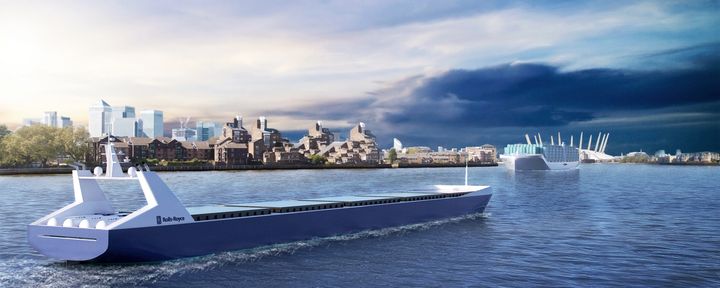
Concept of a Roll Royce autonomous ship approaching London.
There was once a time when self-driving cars felt like something out of a science fiction movie, but the reality is that self-driving, autonomous vehicles are here, and may be on the road sooner than once thought.
Yet that’s far from the coolest and most impressive vehicular technology coming in the near future.
For those in the shipping industry, the autonomous cargo ship has even greater implications. Imagine a ship that could carry cargo with no crew on board.
The technology is not as far away as you might think.
Japanese Anticipating Arrival Within the Decade
How soon is this technology going to be ready to hit the open sea? Shipping firms in Japan are anticipating the development of remote-controlled cargo vessels as early as 2025.
Rolls-Royce is also working on the technology and indicates it could be within the next 10 to 15 years that fully autonomous oceangoing cargo ships are routine in the shipping industry.
How is this possible? The growing digital connectivity and satellite network is making it possible for a greater level of communication between devices that are connected to the Internet.
Placing these devices on commercial ships can allow them to detect more about their environment, what is near them in the sea and where they are in relation to their destination port. Increasing intelligence among technology allows for the making of changes in a course based on weather forecasts, proximity to other vehicles and other factors sensors take in about the environment.
The improvement in computing, sensors and telecommunications in general may make it possible for many of the roles taken by people to be replaced by computers. Instead of a crew on board ship, the ship can run with the guidance of a captain sitting in an office on shore.
This change would revolutionize the over-the-sea shipping industry, once it is ready to hit the market in full force. Not only would it lower operational costs, but it could also potentially improve safety for those workers that remain employed in the industry.
This technology seems like it’s years away, but the reality is that similar technology has actually already been tested through the military.
The Navy recently tested sea Hunter, an experimental self-driving warship. The ship hunts for enemy submarines without having any crew on board. The effective vessel shows that the technology is ready to go to the next level.
Autonomous Ships Could Make the Seas Safer
While there is likely some measure of skepticism about how safe a self-driving ship would be, the truth is that this technology is proving to be effective on both land and water. In addition, adding autonomous ships to the cargo shipping industry could make the seas safer.
Since the 1920s with the introduction of the Jones Act, shipping companies have had to be quite careful to protect their workers from injuries. Falling objects and slip-and-fall hazards are commonplace onboard ocean vessels, as the turbulent waters and overall wet environment create hazards not found on land.
Equipment on board vessels is by its very nature quite heavy, and impact from equipment can be deadly. Toxic chemicals and extreme temperatures are commonplace on a ship.
The Jones Act outlines many of these hazards and ensures workers are justly compensated for those injures that occur while in offshore employment.
For cargo shipping companies, implementing autonomous vehicles reduces the risk of these types of injuries and the costs they bring. From insurance costs to lost worker productivity, these costs add up quickly, and the risk is significantly reduced when employees spend less time on board ships.
''While the men and women working on these vessels are exposed to many hazardous conditions, it is clear that the human element is necessary for the safety of the environment as well as the public at large,'' explains Attorney Matthew Shaffer.
